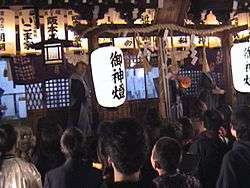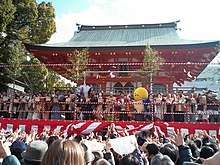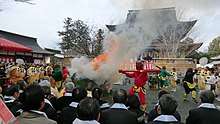Setsubun
Setsubun (節分) is the day before the beginning of spring in Japan.[1][2] The name literally means 'seasonal division', but usually the term refers to the spring Setsubun, properly called Risshun (立春) celebrated yearly on February 3 as part of the Spring Festival (春祭, haru matsuri).[3] In its association with the Lunar New Year, spring Setsubun can be and was previously thought of as a sort of New Year's Eve, and so was accompanied by a special ritual to cleanse away all the evil of the former year and drive away disease-bringing evil spirits for the year to come. This special ritual is called mamemaki (豆撒き, "bean scattering"). Setsubun has its origins in tsuina (追儺), a Chinese custom introduced to Japan in the eighth century.[2]
| Setsubun | |
|---|---|
 Tokuan shrine | |
| Also called | Bean-Throwing Festival, Bean-Throwing Ceremony |
| Observed by | Japanese people |
| Type | religious, cultural |
| Significance | Day before the beginning of spring |
| Date | February 3 |
| Next time | 3 February 2021 |
| Frequency | Annual |
| Related to | Spring Festival (Harumatsuri) |


Mamemaki
The custom of mamemaki first appeared in the Muromachi period.[2] It is usually performed by the toshiotoko (年男) of the household (the male who was born on the corresponding animal year on the Chinese zodiac), or else the male head of the household. Roasted soybeans (called "fortune beans" (福豆, fuku mame)) are thrown either out the door or at a member of the family wearing an Oni (demon or ogre) mask, while the people say "Demons out! Luck in!" (鬼は外! 福は内!, Oni wa soto! Fuku wa uchi!) and slam the door.[4] This is still common practice in households but many people will attend a shrine or temple's spring festival where this is done.[5]:120 The beans are thought to symbolically purify the home by driving away the evil spirits that bring misfortune and bad health with them. Then, as part of bringing luck in, it is customary to eat roasted soybeans, one for each year of one's life, and in some areas, one for each year of one's life plus one more for bringing good luck for the year to come.[6]
The gestures of mamemaki look similar to the Western custom of throwing rice at newly married couples after a wedding.[2]
Other practices
At Buddhist temples and Shinto shrines all over the country, there are celebrations for Setsubun. Priests and invited guests will throw roasted soy beans (some wrapped in gold or silver foil), small envelopes with money, sweets, candies and other prizes. In some bigger shrines, even celebrities and sumo wrestlers will be invited; these events are televised nationally.[7] At Sensō-ji in the Asakusa neighborhood of Tokyo, crowds of nearly 100,000 people attend the annual festivities.[8]
It is customary in Kansai area to eat uncut makizushi called ehō-maki (恵方巻, lit "lucky direction roll"), a type of futomaki (太巻, "thick, large or fat rolls"), in silence on Setsubun while facing the year's lucky compass direction, determined by the zodiac symbol of that year.[9] This custom started in Osaka, but in recent years eho-maki can be purchased at stores in the Kanto area and it is getting more recognized as a part of Setsubun tradition. Charts are published and occasionally packaged with uncut makizushi during February. Some families put up small decorations of sardine heads and holly leaves (柊鰯 hiiragi iwashi) on their house entrances so that bad spirits will not enter. Ginger sake (生姜酒, shōgazake) is customarily drunk at Setsubun.[5]:120
Historical practices
The new year was felt to be a time when the spirit world became close to the physical world, thus the need to perform mamemaki to drive away any wandering spirits that might happen too close to one's home. Other customs during this time included religious dance, festivals, and bringing tools inside the house that might normally be left outside, to prevent the spirits from harming them.[5]:120
Because Setsubun was considered to be apart from normal time, people might practice role reversal. Such customs included girls doing their hair in the styles of older women and vice versa, wearing disguises, and cross-dressing. This custom is still practiced among geisha and their clients when entertaining on Setsubun.[5]:120–121
Traveling entertainers (旅芸人, tabi geinin), who were normally shunned during the year because they were considered vagrants, were welcomed on Setsubun to perform morality plays. Their vagrancy worked to their advantage in these cases because they could take the spirits with them.[5]:121
Regional variations
While the practice of eating makizushi on Setsubun is historically only associated with the Kansai area of Japan, the practice has become popular nationwide due largely to marketing efforts by grocery and convenience stores.[10]
In the Tōhoku area of Japan, the head of the household (traditionally the father) would take roasted beans in his hand, pray at the family shrine, and then toss the sanctified beans out the door.[11]
Peanuts (either raw or coated in a sweet, crunchy batter) are sometimes used in place of soybeans.[12]
There are many variations on the famous Oni wa soto, fuku wa uchi chant. For example, in the city of Aizuwakamatsu, people chant "鬼の目玉ぶっつぶせ!" (Oni no medama buttsubuse!), lit. "Blind the demons' eyes!".[11]
See also
- Ehōmaki, a sushi roll often eaten for good luck on setsubun.
- Exorcism
- Feast of the Lemures (a similar Roman custom)
- Holidays of Japan
- Rikka (立夏)
- Risshū (立秋)
- Risshun (立春)
- Rittō (立冬)
- Taoism in Japan
- Zvončari (the custom dating to pagan times in Croatia whose goal is to scare away evil spirits of winter and to stir up new springtime cycle)
References
- Thacker, Brian (2005). The Naked Man Festival: And Other Excuses to Fly Around the World. Allen & Unwin. p. 61. ISBN 1-74114-399-3.
- Sosnoski, Daniel (1996). Introduction to Japanese culture. Tuttle Publishing. p. 9. ISBN 0-8048-2056-2.
setsubun.
- "Religions – Shinto: Haru Matsuri (Spring festivals)". BBC. Retrieved March 10, 2014.
- Craig, Timothy J. (2000). Japan pop!: inside the world of Japanese popular culture. M.E. Sharpe. p. 194. ISBN 0-7656-0561-9.
- Dalby, Liza Crihfield (1983). Geisha. University of California Press. ISBN 0-520-04742-7.
setsubun.
- Karl, Jason (2007). An Illustrated History of the Haunted World. New Holland Publishers. p. 62. ISBN 1-84537-687-0.
- Mishima, Shizuko. "Setsubun – Bean Throwing Festival". About.com. Retrieved February 1, 2011.
- "Setsubun Is Right Around the Corner". Japan Travel Bureau. January 29, 2014. Retrieved February 2, 2014.
- "Setsubun – Around February 3". Massachusetts Institute of Technology. March 5, 2002. Retrieved February 2, 2014.
- Lapointe, Rick (February 3, 2002). "Are you ready to roll with the change on 'setsubun no hi'?". The Japan Times. Retrieved February 2, 2014.
- Shurtleff, William; Aoyagi, Akiko (December 2012). History of Soynuts, Soynut Butter, Japanese-Style Roasted Soybeans (Irimame) and Setsubun (with Mamemaki) (1068–2012): Extensively Annotated Bibliography and Sourcebook. Soyinfo Center. p. 521. ISBN 9781928914532. Retrieved February 2, 2018.
- "Setsubun 節分". Japan Reference. Retrieved February 2, 2014.
External links
| Wikimedia Commons has media related to Setsubun. |
| Look up Setsubun in Wiktionary, the free dictionary. |